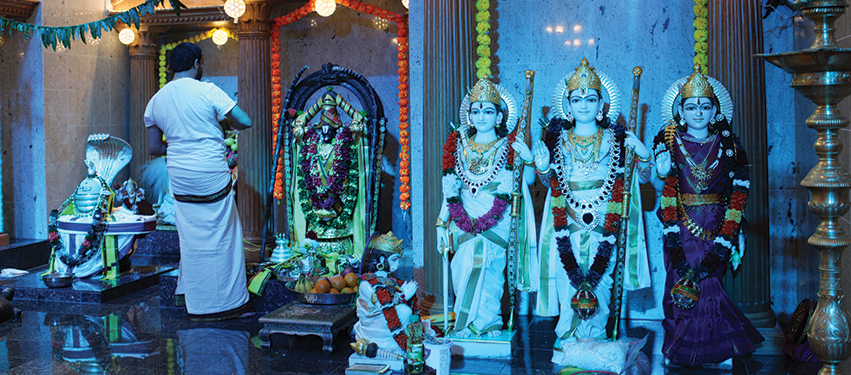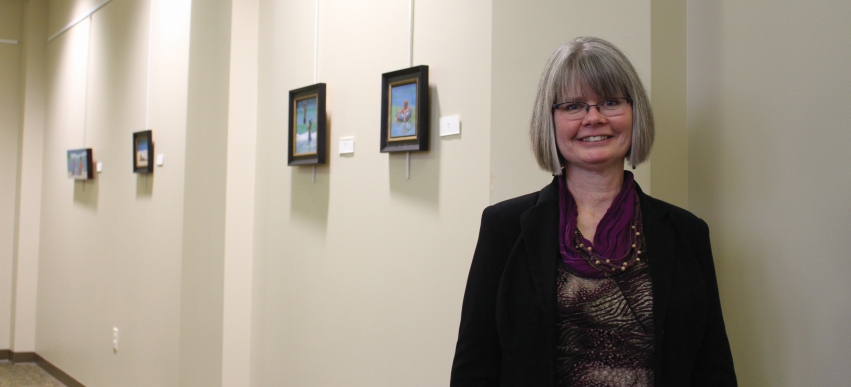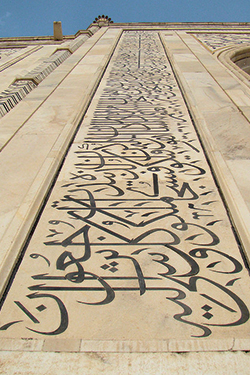Religious art, in a variety of forms, reveals a common yearning for hope and transcendence.
Sacred art has been an essential part of the human story for millennia. From Paleolithic cave paintings to contemporary religious icons, we have long been inspired by a belief in the divine. Here in Peoria, creative spiritual expression can be found in a host of forms, from the annual Bach Festival at Trinity Lutheran Church and weekly Jazz Vesper service at Westminster Presbyterian, to the museums within the Catholic diocese and the ceiling of St. Mary’s Cathedral.
Unquestionably, there are countless opportunities to survey the intersection of art and spiritual conviction. What follows is merely a handful, but each offers a unique approach to faith, creativity and cultural tradition.
Decorations of Meaning
Anshai Emeth is one of the oldest Reform Judaism congregations in the country, having worshipped in numerous locations, including various Christian churches, during its nearly 160-year history. After a fire destroyed its temple in 1896, a new temple rose up at the corner of Monroe and Hancock in downtown Peoria two years later. “It looked like a Christian church,” notes Steven Marx, board member and former Sunday school principal. “In fact, it was taken over by a Christian church when we moved out of it.”
Because religious architecture is often integral to a congregation’s identity, this might seem surprising, but Marx says it is not unusual. “Assimilation was a big deal,” he affirms. Today, the building is occupied by the Christian Assembly Church, which continues to maintain its ornate stained glass windows and other artifacts of Jewish symbolism, revealing the building’s evolving history.
In the 1960s, architect Gyo Obata was hired to design a new space for Anshai Emeth. Known for his work on the National Air and Space Museum in Washington, DC and the McDonnell Planetarium in St. Louis, Obata conceived of a structure that emulated the rallying cry of 20th-century modernist architecture: form follows function. Though its interior is mostly bare, rainbows of color cut through the sanctuary when the light is just right, spilling through stained glass onto a large tapestry hanging prominently on the wall.
 “It was made by one of our women’s groups over 50 years ago,” Marx explains. “In Christianity, you have figures like Mary, Jesus or the saints. We don’t have that. Instead, you’ll see the Star of David, the Torah and the Tree of Life.”
“It was made by one of our women’s groups over 50 years ago,” Marx explains. “In Christianity, you have figures like Mary, Jesus or the saints. We don’t have that. Instead, you’ll see the Star of David, the Torah and the Tree of Life.”
The name of the congregation—Anshai Emeth, written right to left in Hebrew—runs across the top of the tapestry, while its English translation, “Men of Truth”—which can be translated more broadly as “People of Truth,” Marx adds—decorates the bottom. Along its left and right edges, the signs of the Hebrew Zodiac surround a rich collection of imagery from the Jewish tradition. Marx chuckles, noting the “Live long and prosper” salute made famous in Star Trek. “Leonard Nimoy, who played Spock, was Jewish,” he explains. “The salute was actually based on a Jewish priestly blessing.”
At the front of the sanctuary, a set of doors protect the synagogue’s scrolls, which are ornately decorated with gold and velvet. While the doors might appear to be painted with random geometric shapes, they, too, carry meanings deeply entrenched in the Jewish faith. Across the top, in highly stylized Hebrew, is the phrase l’dor v’dor (“from generation to generation”)—“an important concept in Judaism,” Marx explains. Their golden handles also convey meaning: they are shaped like the two Hebrew letters that represent the name of the Jewish God. Because this name is considered sacred, it is not pronounced, but instead replaced with Adonai, or “Lord.”
The lack of any “graphical representation of human beings is a traditional practice among Jews,” notes Rabbi Daniel Bogard, who served the congregation before moving to Cincinnati last year. “[It is] a statement that the idea of ‘God’ has nothing in common with the idea of the ‘human’… other than the possibility of creativity, which is how we understand the concept of ‘made in the image of God.’”
The Divinity Within
At the Hindu Temple of Central Illinois, religious meaning is expressed in a variety of artistic forms. Prakash Babu, one of the temple’s founders, describes it as a “temple of temples,” explaining that Hinduism is an amalgamation of religious and cultural traditions that does not recognize a single founder or prophet. “There is one God, but there are many manifestations,” he notes. “People come here looking for divinity, without knowing there is divinity within themselves.
“What do you see?” Babu asks as we approach the sanctuary early on a Saturday afternoon. As worshippers chant and pray, the white marble and black granite figures of deities cast a striking presence, decorated in ornamental jewelry and colorful garlands. The aroma of incense floats amidst music and the glow of multicolored lights, showering the gods and goddesses in ever-changing, kaleidoscopic hues, while the temple’s priest performs pujas, or prayer rituals, for those who have gathered.
“The marble carvings are truly amazing,” says Babu, motioning toward the central statues of Brahma, the creator; Vishnu, the preserver; and Shiva, the destroyer and transformer. These deities form the Hindu Trimurti, or trinity: the three forms of the Divine Being. Before the Trimurti sits the lingam, an elliptical rock and symbol of Lord Shiva, which represents formless being, Babu explains. “We like to think that the universe is infinite—it has no form and can go in any direction.”

All of these pieces were hand-carved in India, with exquisite levels of detail sustaining their lifelike aura. While most Hindu temples are devoted to a single deity, the Peoria temple appeals to many traditions, allowing the faithful to worship in their own preferred manner. There is even a carving of Mahavira, a venerated teacher from the ancient Indian religion, Jainism. “We have many sects here,” Babu explains. “For a smaller community like ours, it makes a lot of sense to bring people from many denominations under one roof.”
The elaborate artwork, he notes, is meant to invoke epic stories and lessons in temple devotees. “In the past, the stories were not written—they were poems passed down by oral tradition. For thousands of years, the poetry was memorized and chanted,” he explains, citing this rich tradition in the Hindu faith.
Behind the sanctum, a circular aisle leads worshippers past small pockets in the walls containing additional carvings and artwork, each alluding to these ancient stories. Near one of them, Babu pauses to point out the elegance of Lakshmi, Lord Vishnu’s wife. “She is the goddess of love and is worshipped for prosperity. She is very popular,” he adds with a smile.
Windows to Heaven
Not all places of worship are easily identified from the outside—and that is certainly true of the St. Elias Antiochian Orthodox Mission, located on Sheridan Road in the heart of Peoria. Tucked behind a small tailoring shop, the unassuming white building bears little resemblance to a traditional church. Inside, however, the harsh outside world fades into warm candlelight and billowing incense, its walls covered with Christian iconography. The contrast is intentional, explains Father Habib Ghantous. “When you walk in, your first reaction is wow. Where am I? Am I on earth… or am I in heaven?”
Though it might feel like stepping into an ancient era, nearly everything in the sanctuary was created in the last 15 years. When the congregation got started, it lacked the funds to purchase original works of art. “We had no budget, so we had to make something out of nothing,” Fr. Ghantous explains. “Normally, icons are hand-painted, but a friend sent me pictures of icons from his own church, and a local printing shop was gracious enough to print them out for us.” The prints were then attached to wooden boards, cut and crafted by Fr. Habib himself. Recently, the church acquired its first original, hand-painted icon—a depiction of St. George that is over a century old.

“A lot of people think we worship icons,” Fr. Ghantous says, “but icons are nothing more than a window to heaven for us… When you look into the eyes of an icon that depicts Christ, you can’t help but be humbled.” Icons have also served a practical purpose in Christianity, he adds, as painted religious scenes allowed illiterate Christians to learn the stories of biblical figures and saints.
These icons are accompanied by symbolism rooted in the earliest Christian communities, and the use of nomina sacra, or “sacred names,” is ubiquitous. When early Christians copied the Greek manuscripts preserving their sacred scriptures, they began to abbreviate divine names and titles—a practice adopted by artists to identify the figures in the icons. These sacred names are even stamped on the bread used in the Sacrament of Holy Communion, Fr. Ghantous notes, pointing to the Greek letters IC XS, an abbreviation for Ihsous Christos, or “Jesus Christ.”
While St. Elias embraces strong visual elements, it lacks the musical tradition that many Christians find familiar. “Music is not allowed inside of the church,” he explains. “We use Byzantine chants for our entire liturgy.” This involves physical gestures and chanted responses from both Fr. Ghantous and the congregation, in what amounts to a multi-sensory experience. “Movement is important in our church. It’s all about the senses… The incense reaches to you as heaven. We believe that what we do here is what is done in heaven: praising God.”
The Breath of God
Protestantism tends to reject the ornate art forms found in Roman Catholic and Orthodox churches—instead favoring the symbolism of simple, unadorned crosses and at times, colorful stained glass. Carol McPherson, Director of Discipleship and Fine Arts Ministries at First United Methodist Church (FUMC) in downtown Peoria, says their congregation echoes that tradition.
“It’s minimalist and moves away from iconography… from anything ornate,” she says, though her job title might reflect an evolution in this general feeling toward the visual arts. “People are more and more coming on board with how the visual plays into being fully formed as human beings and people of faith.”

When McPherson was hired in 2013, the church was in the process of remodeling, and she noticed that the large, second-floor space above the new entryway remained empty. “I thought it would be a fabulous place for a gallery,” she recalls. Sensing an opportunity to make overt the connection between art and faith, the Foster Gallery for Christianity and the Fine Arts was born.
“I believe art is God-breathed,” McPherson notes. “I like to see this gallery as an opportunity to provide a prophetic word.” Soon, the gallery joined CIAO (Central Illinois Artists Organization) and opened up to local artists and musicians on First Fridays. Their first exhibit highlighted the work of local fiber artist Trish Williams. “She had beautiful, amazing quilts,” says McPherson. “Some had pictures of African-American men who had been shot by police… So we saw beauty, but then there was a prophetic word that called us to ask: Who are we in relationship to God and other people in his creation?”
This question is posed in a variety of ways—some obvious, some requiring a bit of reflection. Recently, McPherson scheduled an exhibit entitled Breath of Summer, featuring paintings of sandy beaches and sunlight to contrast the gray skies of the Midwestern winter. “It speaks to the hope of light and warmth that is to come,” she says. “It brings beauty and hope.”
While the artwork featured at FUMC is not always religious in nature, McPherson says she always reserves two periods of time specifically for Christian topics: Advent and Lent. This year, Lent opens on the First Friday in March, offering an opportunity for dialogue about the focus of the season: brokenness and redemption. “We are going to have interactive ‘Stations of the Cross’ exhibits with images of suffering in need of redemption,” she notes. “Whether it is across the world in Aleppo or homelessness here in Peoria… it will ask people to reflect on what brokenness is in their lives and in their world. What is in need of healing?”
Script and Pattern In Islamic tradition, creative expression is most prominent in script, as Muslims connect artistically to God through their holy scripture, the Koran. “When you look at… the Gothic architecture found in Roman Catholic churches or the icons found in the Eastern Church, we do not have anything of that nature,” explains Imam Kamil Mufti of the Islamic Foundation of Peoria. “What we have is calligraphy.”
In Islamic tradition, creative expression is most prominent in script, as Muslims connect artistically to God through their holy scripture, the Koran. “When you look at… the Gothic architecture found in Roman Catholic churches or the icons found in the Eastern Church, we do not have anything of that nature,” explains Imam Kamil Mufti of the Islamic Foundation of Peoria. “What we have is calligraphy.”
With its ornate and beautifully illustrated passages, calligraphy is perhaps the most important element of Islamic art, facilitated by the ornamental nature of Arabic script. Another central concept is the lack of figurative imagery—a result of the belief that God cannot be depicted, says Imam Mufti. “The idea is that God is beyond human imagination.”
Islamic calligraphy is often combined with intricate geometric or floral patterns known as arabesque—and the breathtaking results can be seen across the Muslim world. In addition to decorating pottery, woodwork, textiles and other objects, “there is a very rich tradition in architecture, but it is not as common or elaborate in North America,” explains Imam Mufti. “There are two large and beautiful [mosques] in Washington, DC… [Other] mosques, like the one in Peoria, are more functional.”
The concept of the Islamic garden, he adds, is also among the highest forms of visual art in Islam. While they, too, are rare in North America, “you will see them in India and across Africa,” most notably at the Taj Mahal, a crown jewel of Islamic architecture. Traditional Islamic gardens are places of rest, prayer and contemplation, Imam Mufti explains, “a reflection of paradise on earth.”
Faith and Hope
Across each of these ancient traditions, the faithful are moved to create as a form of veneration and worship. Sacred art is a common thread that spans the course of human history, expressing a collective, hopeful optimism for that which transcends the mundane. And regardless of faith or creed, for the religious and non-religious alike, there are great benefits to be found in hope. a&s
Mae Gilliland Wright has a PhD from the University of Edinburgh's New College School of Divinity and is Vice President of ArtsPartners of Central Illinois' Board of Directors.


